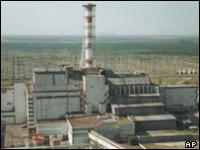







|
News and Information
Europe stages nuclear crisis test
| May 11, 2005 |

Chernobyl reactor
The exercise tests lessons learned since the 1986 Chernobyl disaster
Nuclear experts are simulating a major accident at a power plant in Romania to test the global response to a disaster.
More than 60 countries are taking part in the 36-hour test, organised by the UN atomic energy agency and centred on the Cernavoda nuclear power station.
The test began at 0600 (0300 GMT) when nuclear fuel was said to have spilled from a pipe in the core of the reactor.
Emergency response teams in Romania are tackling the situation, while other countries are tracking nuclear fallout.
Full details are being kept secret to make the simulated accident as real as possible for emergency teams.
Disaster unfolding
In this morning's test scenario at Cernavoda - some 180km (100 miles) south-east of the Romanian capital, Bucharest - a containment vessel failed after a fuel leak in one of 300 pipes in the reactor's nuclear core.
That allowed a major release of radioactive material into the atmosphere.
Local residents were told to act as if the emergency were real, stay indoors and drink only bottled water.
The BBC's Nick Thorpe, at Romania's nuclear headquarters in Bucharest, says there is an atmosphere of calm urgency among staff.
Romania's five international neighbours have been placed on alert, while the International Atomic Energy Agency (IAEA) in Vienna and World Health Organization (WHO) in Geneva were also contacted.
Lessons of Chernobyl
About 60 nations are monitoring developments in the test and co-ordinating a wider international response, including tracking possible nuclear fallout.
A radiation warning sign
One-fifth of Belarus' farming land is still contaminated by Chernobyl
The last similar test was one held at the Gravelines nuclear power plant on the northern coast of France in May 2001.
Planners hope to incorporate lessons learned in the 19 years since the devastating Chernobyl accident in Ukraine.
Experts involved in planning the exercise have stressed the likelihood of a major nuclear accident is very low, but contingency plans must be in place.
Chernobyl was the world's worst civilian nuclear disaster and led directly to the deaths of 30 workers at the reactor site, while hundreds of others were treated in hospital.
About 6.7 million people were exposed to radiation fallout, according to the WHO, which led to a 10-fold increase in thyroid cancer among children in affected areas. |
Source: www.bbc.com |
| http://news.bbc.co.uk/2/hi/europe/4535899.stm |
|
| Support Caprivi Freedom |
Fill out the form below to become a member of this site and receive our regular newsletter.
|

|

